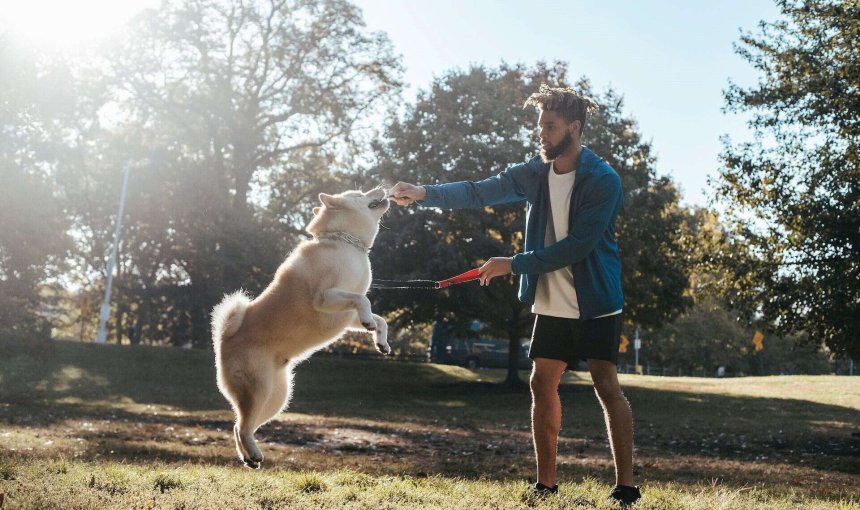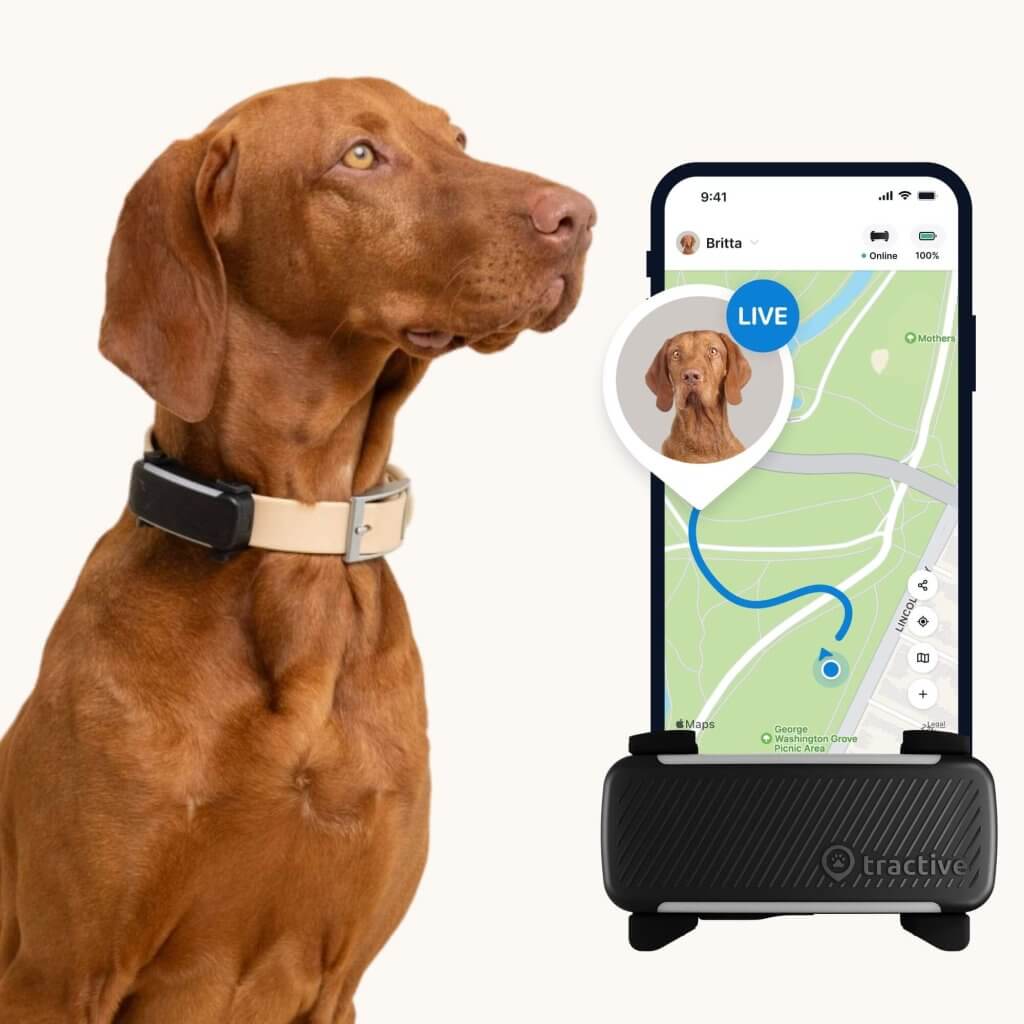Clicker Training for Dogs: How To Get Started
Clicker training: a smart, fun way to positively reinforce your dog and teach them new tricks. Here's how you can get started in no time.

As adorable as our furry friends can be, you do need an effective way to train them – while also keeping them happy. Enter clicker training for dogs: a smart, fun way to positively reinforce your buddy and teach them new tricks.1 In this article, we’re covering a step-by-step guide to get started. (And what you can do in case your buddy wanders off due to distraction or boredom mid-training!)

Always know your buddy is healthy & safe
Read more- What’s clicker training for dogs all about?
- Where does dog clicker training work in real life?
- Can I clicker train a puppy or an older dog?
- Before getting started with training
- How to train your dog with a clicker: Step-by-Step
- Clicker training for advanced commands
- Tips for (p)awesome clicker training sessions with your dog
- A happier, better-trained dog – in just a few clicks
What’s clicker training for dogs all about?
Clicker training is all about positively reinforcing2 new behaviors in your dog – all with the use of a clicker. That’s a small handheld device that comes in both mechanical and plastic forms and makes a distinct “click” sound when you use it. When your dog obeys your command, you:
- Sound off your clicker.
- Wait just a half-second.
- Offer your dog a treat.
The sound of your clicker gives your dog a clear, consistent signal that communicates to them, “Good job!” It’s a great, simple way to improve your relationship and communicate more effectively with your dog.
Because while you might’ve been telling your dog “Good!” or “No!” in response to their behaviors, your voice might not always be consistent. In many cases, your dog might not be able to tell the difference between you being happy or upset with them.
On the other hand, a clicker has a consistent and distinct sound that your dog can easily recognize. Over time, they’ll begin to associate this sound with “good” behaviors – and adjust accordingly.
Where does dog clicker training work in real life?
Clicker training isn’t just a way of teaching your dog to sit or stay. It’s a versatile, tried-and-trusted method that has a whole bunch of awesome real life applications. Here are some of them:
- Behavioral issues
Some dogs might tend to jump, bark, bolt, or pull on their leashes. Clicker training is a great way to help them slowly, gradually unlearn these aggressive behaviors.3 - Teaching your (old) dog new tricks
Clicker training works for dogs of all ages: from puppies to older dogs.4 These include tricks like rolling over, playing dead, or even agility training.
Training service and therapy dogs
Clicker training helps these dogs learn how to best perform tasks to aid persons with disabilities5 or offer the emotional support they need.
Can I clicker train a puppy or an older dog?
Yes! Clicker training works for dogs of all ages – puppies, senior dogs, and every dog in between. Dogs of all ages and personalities respond well to positive reinforcement.
Just remember to start slow and take it easy with basic commands at first, so that your puppy can follow along. It’s a great way to bond in a safe, trusting way with your little buddy and set them up for a lifetime of positive emotional development.
For older dogs, experiment with what treats they’re best motivated with at first. If you’ve, say, adopted an older dog, they might have a bit more of an established personality. So, for example, they might respond better to hugs and head pats than treats.
Before getting started with training
Here are a couple of steps we’d recommend you take before getting started with clicker training with your dog.
- Use a good clicker
Ideally your clicker is one that’s comfortable to hold and has a distinct clicking sound. You can easily find one at your local pet store or online. However, in place of a clicker, you can also whistle or make any other sound. (Just be sure to be consistent with it.) If your dog is hearing-impaired, you can tap them gently on the shoulder. - Train in a quiet, familiar environment
This prevents your dog from feeling stressed, and also helps them focus without distractions and hear the clicker more easily. This could be your backyard, your garage, living room – anywhere your dog feels comfortable. - Plan ahead for distractions
When you combine a distraction-filled environment with a high energy dog, you might see them bolting or running off at new sights, sounds, or smells every minute. With a dog GPS tracker, for example, you can follow your dog’s movements in real-time – down to the smallest movement. So you can both clicker train your dog and stay on top of where they’ve run off to, stress-free.

Follow your dog anywhere
Get real-time location information, wherever they go. And find out when they try to make an escape, or just when they go somewhere they shouldn’t, with Virtual Fences.
How to train your dog with a clicker: Step-by-Step
Get your dog used to their clicker
Start your training in the quiet, familiar environment you’ve picked. Sound your clicker once – and give your dog a treat right after. Repeat these steps a couple of times. Your dog will slowly learn to associate the sound of your clicker with a treat.
Start with basic commands
Now let’s start with teaching your dog some basic commands. Once they’ve learned that the sound of your clicker = treat, you can start with the:
Sit command
- Your dog might already be sitting – but if not, just wait for them to do so. Or you could gently guide them into it (maybe by sitting down yourself or gently, insistently telling them “Sit”.)
- The moment they’re seated, sound your clicker and give them a treat.
- Repeat this process until your dog consistently sits the minute they hear the sound of the clicker.
Stay command
- Start with your dog when they’re sitting.
- Holding your hand out in a “Stop” gesture, take a step back. Or slowly, clearly tell them “Stay.”
- Is your dog still seated? Click and treat.
- If not, guide them into sitting again and repeat the process until they stay.
- Gradually increase the duration between clicks to encourage your dog to “stay” longer.
Lay down command
- Begin while your dog is sitting.
- Hold a treat close to their nose and slowly lower it until you can place it on the ground. Slowly, clearly, tell them “Lay down.”
- Your dog will follow the treat as you lower it – once it’s low enough that they have to lie down, sound your clicker and give them the treat.
Clicker training for advanced commands
Responding to “Come!”
- Get a friend or family member to hold your dog on a leash a short distance away.
- Crouch down, open your arms, and call your dog’s name followed by “Come!”
- Once your dog reaches you, click and reward.
Paw/shake
- Gently tap your dog’s paw and tell them, “Paw” or “Shake”.
- Once they offer you their paw, click and reward.
Fetch
- Toss one of your dog’s toys a short distance away and tell them, “Fetch!”
- When your dog retrieves their toy and brings it back, click and reward.
As with the basic commands, repeat these steps to positively reinforce your dog into associating the sound of the clicker with the behavior you’re training them to follow.
Tips for (p)awesome clicker training sessions with your dog
- Work on one command at a time
Don’t move on to the next command until your dog has mastered the one you’re working on together now. - Keep your sessions short and sweet
Aka, no more than 15 minutes. This will keep your dog interested and motivated and prevent them from feeling frustrated. - Don’t skip on regular practice
It’s important to be consistent with the clicker so that you don’t accidentally reward a “bad” behavior. Practice initially with some simple behaviors your dog tends to do instinctively (like sniffing.) With time and practice, you’ll get better and more consistent with clicking right after your dog performs a “good” behavior. - Patience is key
Some dogs might need a little more time to adapt to any kind of training – while others might just blaze right through. Be patient and adjust your training style to fit how your dog learns. - Avoid scolding or punishing your dog
Clicker training is built on positively reinforcing “good” behaviors – so communicating your expectations clearly to your dog. Remember that they might not always understand commands, so take it slow and build up practice gradually.
A happier, better-trained dog – in just a few clicks
Dogs respond pretty positively to clear, predictable rewards – and with a clicker at hand and a bit of consistency, you’re on your way to a happier, better-trained buddy in no time. Remember to start simple and get plenty of practice using your clicker at first, so that your dog can clearly understand what you’re expecting of them. So grab those treats, your clicker, and let’s get started!



